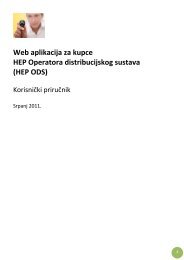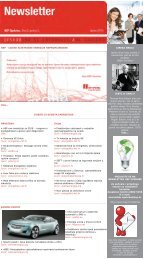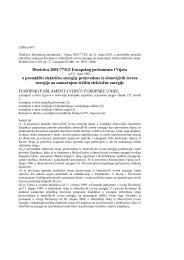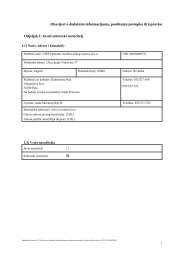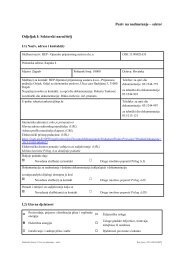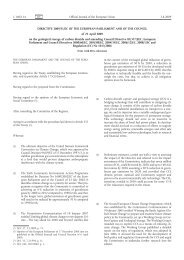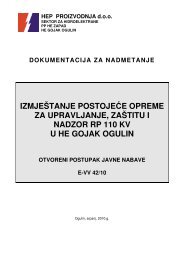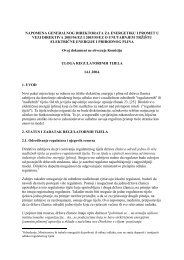DRAVA, KUPA, RJE»INA, LOKVARKA, LI»ANKA LIKA, DOBRA ...
DRAVA, KUPA, RJE»INA, LOKVARKA, LI»ANKA LIKA, DOBRA ...
DRAVA, KUPA, RJE»INA, LOKVARKA, LI»ANKA LIKA, DOBRA ...
You also want an ePaper? Increase the reach of your titles
YUMPU automatically turns print PDFs into web optimized ePapers that Google loves.
124<br />
HEP ANNUAL REPORT 2010<br />
CHAPTER 6 - FINANCIAL STATEMENTS<br />
NOTES TO THE CONSOLIDATED FINANCIAL<br />
STATEMENTS OF THE HEP GROUP (CONTINUED)<br />
FOR THE YEAR ENDED 31 DECEMBER 2010<br />
37. FINANCIAL INSTRUMENTS (continued)<br />
CREDIT RISK MANAGEMENT<br />
Credit risk refers to the risk that counterparty will default on its contractual obligations resulting in financial loss<br />
to the Group. The Group is the sole provider of electric energy in the Republic of Croatia. As such, it has a public<br />
responsibility to provide services to all users, and locations within the country, irrespective of credit risk associated<br />
with particular customers. Trade receivables, net, consist of a large number of customers, spread across diverse<br />
industries and geographical areas.<br />
The Group does not have any significant credit risk exposure to any single counterparty or any group of counterparties<br />
having similar characteristics. The Group defines counterparties as having similar characteristics if they are<br />
related entities. Credit risk with respect to trade receivables is primarily related to domestic corporate receivables, specifically<br />
where services are provided to economic concerns, which are in a difficult financial position. Overdue receivables<br />
from households are limited due to Group’s ability to disconnect such customers from the power supply network.<br />
Except as detailed in the following table, the carrying amount of financial assets recorded in the financial<br />
statements, which is net of impairment losses, represents the Group’s maximum exposure to credit risk without<br />
taking account of the value of any collateral obtained.<br />
LIQUIDITY RISK MANAGEMENT<br />
Ultimate responsibility for liquidity risk management rests with the Management Board, which has built an appropriate<br />
liquidity risk management framework for the management of the Group’s short, medium and long-term funding<br />
and liquidity management requirements. The Company manages liquidity risk by maintaining adequate reserves,<br />
banking facilities and other sources of financing, by continuously monitoring forecast and actual cash flows and<br />
matching the maturity profiles of financial assets and liabilities.<br />
Liquidity and interest rate risk tables<br />
The following table details the remaining period to contractual maturity for the Group’s non-derivative financial assets.<br />
The tables below have been drawn up based on the undiscounted cash flows of the financial assets including interest that<br />
will be earned on those assets except where the Group anticipates that the cash flow will occur in a different period.<br />
MATURITY OF NON-DERIVATIVE FINANCIAL ASSETS<br />
Weighted<br />
average<br />
effective<br />
interest rate<br />
Less than 1<br />
month<br />
1 – 3<br />
months<br />
3 – 12<br />
months<br />
% (HRK’000) (HRK’000) (HRK’000) (HRK’000) (HRK’000) (HRK’000)<br />
2010<br />
Non-interest bearing 1,096,670 1,424,595 194,103 396,981 21,317 3,133,666<br />
Variable interest rate<br />
instruments<br />
5.00% 23 46 196 105 - 370<br />
Total<br />
2009<br />
1,096,693 1,424,641 194,299 397,086 21,317 3,134,036<br />
Non-interest bearing 1,179,933 676,596 179,562 484,635 16,569 2,537,295<br />
Variable interest rate<br />
instruments<br />
6.00% 24 47 207 376 - 654<br />
Total 1,179,957 676,643 179,769 485,011 16,569 2,537,949<br />
1 – 5<br />
years<br />
Over 5<br />
years<br />
Total



